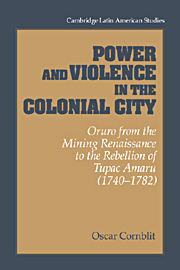 Power and Violence in the Colonial City
Power and Violence in the Colonial City Book contents
- Frontmatter
- Contents
- List of figure, maps, and tables
- Preface
- Map 1 Present-day Bolivia and surrounds
- Map 2 Principal routes of the Viceroyalty of Peru (second half of the eighteenth century)
- 1 Oruro between two epochs: a mining cycle
- 2 Under Spanish law
- 3 Oruro in 1741: details of a stormy election
- 4 The people
- 5 “Madmen, comedians, and hypocrites”
- 6 Captains of shipwreck
- 7 Returning to the known
- 8 “The fruits of the earth”
- 9 The end of an epoch: the Indian uprisings of 1780–1781
- 10 Oruro in the economic and geopolitical context of the epoch (c. 1780–1781)
- 11 The Oruro uprising
- 12 The voice of the rebels
- 13 Picking up the pieces
- Appendix A Indian raids on Oruro, 1781: testimonies
- Appendix B Testimonies of inhabitants of the city
- Appendix C Table of public jobs in Oruro, 1730–1784
- Bibliography
- Index
- CAMBRIDGE LATIN AMERICAN STUDIES
11 - The Oruro uprising
Published online by Cambridge University Press: 30 March 2010
- Frontmatter
- Contents
- List of figure, maps, and tables
- Preface
- Map 1 Present-day Bolivia and surrounds
- Map 2 Principal routes of the Viceroyalty of Peru (second half of the eighteenth century)
- 1 Oruro between two epochs: a mining cycle
- 2 Under Spanish law
- 3 Oruro in 1741: details of a stormy election
- 4 The people
- 5 “Madmen, comedians, and hypocrites”
- 6 Captains of shipwreck
- 7 Returning to the known
- 8 “The fruits of the earth”
- 9 The end of an epoch: the Indian uprisings of 1780–1781
- 10 Oruro in the economic and geopolitical context of the epoch (c. 1780–1781)
- 11 The Oruro uprising
- 12 The voice of the rebels
- 13 Picking up the pieces
- Appendix A Indian raids on Oruro, 1781: testimonies
- Appendix B Testimonies of inhabitants of the city
- Appendix C Table of public jobs in Oruro, 1730–1784
- Bibliography
- Index
- CAMBRIDGE LATIN AMERICAN STUDIES
Summary
The account from which the history of the uprising of the city of Oruro in 1781 as traditionally told is called “Diario del tumulto,” apparently an eyewitness account by a person present at the events who signed anonymously as “a priest.” It is a letter report to an addressee who is also anonymous and living elsewhere, in which the author wants to offer his own interpretation of what happened. In his text, he alludes to “another diary,” written doubtless by Bishop Menéndez, vicar of the principal church in Oruro (although he does not expressly mention his name), who was an unconditional ally of the Rodríguez family. According to the author, the bishop's version was an anti-Spanish libel whose falsehoods he would try to refute by contributing his own version – which, of course, he saw as impartial and objective.
The vicar of the cathedral, Bishop Menéndez, did not sign his diary, but did not go to great pains to conceal his authorship either. The diary is to all appearances written in support of the Rodríguez party. The author's concern basically centers around the defense of his actions and the limitation of his responsibility for the death of several Spaniards, which later earned him a stiff sentence.
Also well known is the transcription by Pedro de Angelis who, although not citing his source, clearly bases his text on the first of these accounts, relieving it here and there of some of its author's excesses of interpretation.
In order to reconstruct what happened during the Oruro uprising we have also consulted the unpublished testimonies of the Indians arrested and tried at the end of the rebellion.
- Type
- Chapter
- Information
- Power and Violence in the Colonial CityOruro from the Mining Renaissance to the Rebellion of Tupac Amaru (1740–1782), pp. 137 - 160Publisher: Cambridge University PressPrint publication year: 1995


